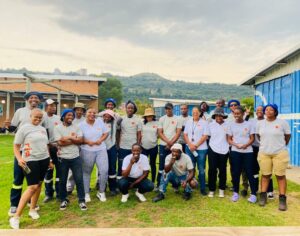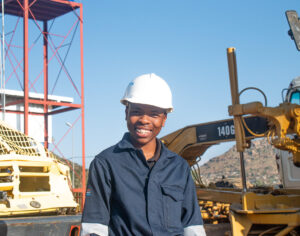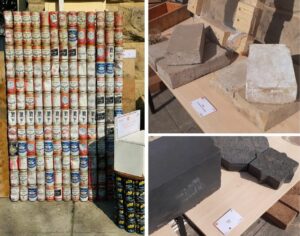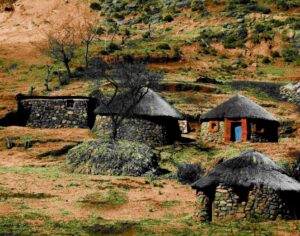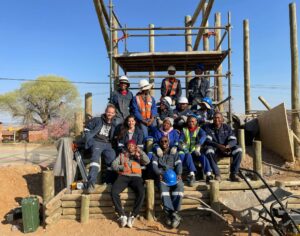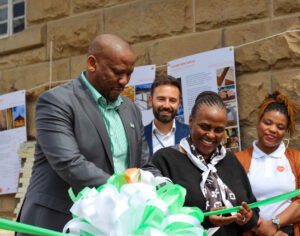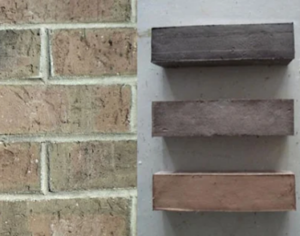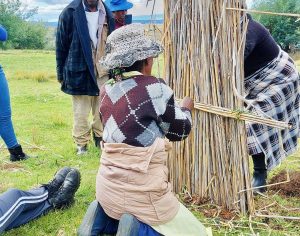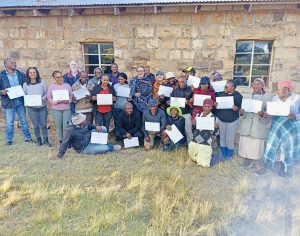Building with Compressed Earth Block
Desk Research & Primary Findings
Issued on: 30th August 2023
Table Of Contents
1. Background
1.2. Overview of Compressed Earth Blocks
Compressed Earth Blocks (CEBs) are a natural infusion of modern technology with one of the earliest elements of man-made structures: the mud brick or adobe block (Bowen 2017). They are essentially moulded adobe blocks produced using mechanical compaction. According to Earth Building and Association of Australia (2022), making CEBs requires dampening the earth and mechanically pressing it along with some sand and a small amount of aggregate binder such as cement at high pressure in a mould, and then setting aside the produced bricks to dry naturally. Studies show that compacted earth has been used before written history, so the utilisation of earth in housing construction is one of the oldest methods used around the world.
Some developing countries are no exception to the adoption and use of CEBs. According to Finnan (2018), the CEB method for construction is not only implemented in Gambia (see figure 1), but also in other African countries such as Burkina Faso, Ghana, and Nigeria as well as Sudan. According to Adam and Agib (2001), various traditional materials have proved to be suitable for a wide range of buildings and have a great potential for increased use in the future, including CEB (See Figure 2). In South Africa, the use of CEBs is gaining popularity. Moreover, Agrément South Africa (2016) has approved the CEB Building system for single-storey buildings.
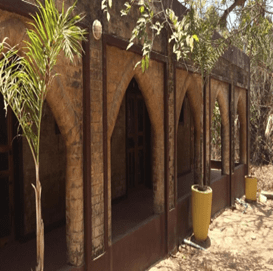
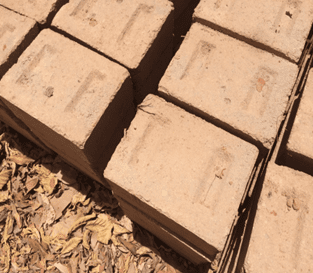
The production of various types of soil bricks, such as adobe, mud bricks, and fired bricks, is quite prevalent in Lesotho, however, CEB has not been used due to a lack of knowledge (Adam and Agib, 2001). As a result, there is a pressing need for research to be conducted on this particular building material.
1.3. Advantages of Compressed Earth Blocks
From an architectural perspective, Compressed Earth Blocks offer similar form and functional qualities as brick, stone, and other masonry units. Moreover, they are more easily produced than stone and are more durable. Furthermore, the structural integrity of the material allows it to be used as a structural wall system that requires minimal reinforcement or additional framing (Bowen 2017).
The capacity of the material to absorb and radiate solar energy as heat is also one of its great advantages (Bowen 2017). This capacity can be termed ‘thermal buffering.’ This means that the material will absorb heat when it is cooler than its surroundings and re-radiate it when it is warmer than the surroundings. The energy-saving effect of thermal buffering is most marked by reducing the need for cooling, but it also has a comforting comfort effect because it reduces internal temperature swings (Bowen 2017).
The materials that go into making CEBs mostly come from nature. There is a reduction in chemicals that are used in the making of these blocks, therefore the material releases no harmful or toxic gas ( Happoadmin, 2022).
The usage of cement (usually about 4-10% of the soil and sand mix depending on the soil composition) is lesser and has the ability for on-site production, curing, and fixing, thus the cost reduction (Nnadi & Delunzu, 2022). According to Happoadmin (2022), CEBs are about 40% cheaper than conventional materials. Therefore, due to their thermal mass quality, CEBs can save anywhere between 10-15% on cooling and heating costs. Also, the time required to manufacture these blocks is minimal.
Manufacturing of CEBs can provide employment opportunities while inculcating social values in them. The compression machines can be powered or operated by hand, and do not require a lot of energy to produce like brick or concrete leading to low carbon emission (Happoadmin, 2022).
1.4. Disadvantages or limitations of Compressed Earth Blocks
When compressed earth block structures are exposed to prolonged weather conditions such as wind and water without proper roofing, they erode easily; however, adding stabilisers like cement improves the strength. Also, there is a time wait with the construction technique, because after the blocks are pressed, materials must dry; therefore the curing duration typically of 28 days also depends on the material used (pure earth with water, cement, or lime for stabilisation). Lastly, failure to mix soils correctly leads to weak blocks that crack easily (Bowen 2017).
2. Primary Explorative Research Findings
To collect primary data, snowballing, and stratified sampling were convenient sampling techniques for this study because it was imperative to select participants with first-hand knowledge about compressed earth bricks from a wide range of professionals and experts who have worked or are working on producing compressed earth bricks. This chapter presents the findings from one face-to-face, 3 calls, and seven Zoom interviews that lasted between 45 minutes to an hour each held in January and February 2023. A set of questions (check Annex 2 questionnaires for CEB) which included open-ended questions, had been prepared with the aim of gathering information about some specific topics such as availability, accessibility, cost, durability, knowledge, and techniques around producing compressed earth bricks.
2.1. Knowledge and techniques used when building using Compressed Earth Bricks
It was crucial to collect information from individuals who possess direct experience in producing Compressed Earth Bricks outside of Lesotho, as there is limited expertise within the country regarding both the production process and the specific machinery involved. All eleven respondents emphasised similar techniques, such as creating a dry mix of suitable soils with water and a small portion of cement for stabilisation. Respondents emphasised that surface soil isn’t utilised due to its organic content for gardening; instead, subsurface soil is preferred. Respondents stated that samples are examined to verify the accurate percentage of components, with a special focus on clay percentage, which can lead to significant expansion and cracking. Additionally, it’s important to assess the presence of rocks in the soil. Similar to clay, these rocks can also lead to cracks and gaps in the blocks. Respondents also indicated that cement is employed for mix stabilisation. The typical cement-to-earth ratio is around 10:90, which strengthens and stabilises the Earth Blocks.
Respondents stated that the strength of CEBs primarily derives from the pressure applied during production. Even with a lower cement content, such as 5% (5:95), it can yield a 7 MPA earth block, matching the compression rating of an inexpensive cement block. Respondents also described the production process using either a manually operated or diesel-powered compressed earth machine, which can be compact and portable. Finally, a machine can also be designed to produce 3 / 4 blocks simultaneously (see video CEB) The last important step Respondents mentioned about the production was the curing period which takes 28 days before being able to be used to build while placing it in the sun.
2.2. Costs and accessibility
Five respondents highlighted the cost-effectiveness of producing CEBs.This is attributed to on-site production, where the soil is readily available and cement usage is minimal compared to conventional bricks. Moreover, basic mechanical machinery for lower-scale production is relatively inexpensive.
One of the respondents indicated large-scale production costs required an outlay of M66 7049 (EUR 33,352) for machinery such as AECT Impact 2001 – a CEB Machine (see Figure 3). However, in the long run, these are offset by fairly cheap operational costs for energy and raw material consumption and usage.
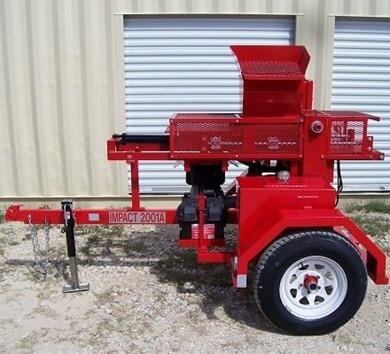
2.3. Environmental Impact of Compressed Earth Blocks
Another key aspect we needed to grasp in our research was the carbon emitted during production and the overall impact of soil extraction. All eleven Respondents confirmed that Compressed Earth Blocks are less harmful to the environment compared to traditional materials. Specifically, producing CEB leads to fewer emissions and significantly less cement/lime per brick. Respondents pointed out that decreasing cement usage results in a significant 50% reduction in embodied carbon emissions. Additionally, Respondents emphasised that producing Compressed Earth Blocks provides a compelling opportunity to utilise earth extracted and processed directly at the construction site.
This offers a notable advantage compared to other materials in that earth is abundant throughout Lesotho, it reduces transportation costs, minimises transport-related pollution, and provides a solution for the displaced earth that is excavated on construction sites.
2.3. Durability of Compressed Earth Blocks
All eleven respondents affirmed that once cured for 28 days, CEBs exhibit durability. They noted that the material’s quality and solidity increase progressively, resulting in buildings that are recognized to endure for over 60 years. However, no compressive strength data was provided by the respondents to determine the optimal earth-to-cement ratio in terms of cost-effectiveness. This ratio varies based on the soil composition and clay content, which differ between sites.
3. Feasibility of Compressed Earth Blocks
There is an industry for earth-based bricks such as Fired bricks,& loti bricks (see Figures 4a, 4b, and 4c) which in Lesotho are manufactured formally in a factory called Loti Bricks as well as provided informally by artisans who create their furnaces on the roadside, against which we can discuss the feasibility of CEBs. This means that the policy framework for the production of CEBs currently exists which makes it viable as an enterprise. The difference in production processes skews the advantage towards CEBs because of lower emissions and fewer materials with embodied carbon (lime & cement). Lastly, there are no speed skills required in the production of CEBs which makes for relatively affordable and accessible labour requirements.
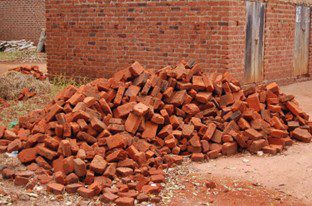
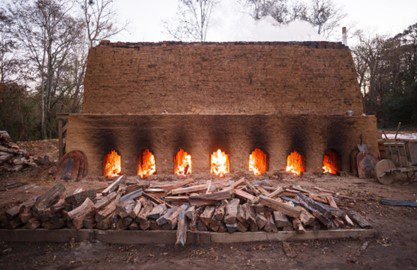
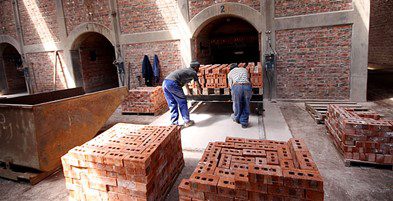
4. Distribution of Compressed Earth Blocks
The distribution of CEBs is tied to two main factors; accessibility of machinery and earth. For an industrial plant, it will be difficult to move the machinery to the building site, unlike the more compact mobile systems, which do not require transportation and warehousing. Since warehousing and transportation for alternative building materials are well developed in Lesotho, CEB companies can piggyback on these systems to distribute their products all over the country.
5. Unmet needs of Compressed Earth Blocks
The CEB market is untapped despite a history of other earth bricks, for instance, adobe bricks, in Lesotho. The oldest buildings in Lesotho are built from adobe and date as far back as 1843. However, there is no record of compressed earth buildings that we could find in Lesotho, although there is a growing interest in the production and use of this technology, one local artisan has made his own CEB machine (see Figure 5).
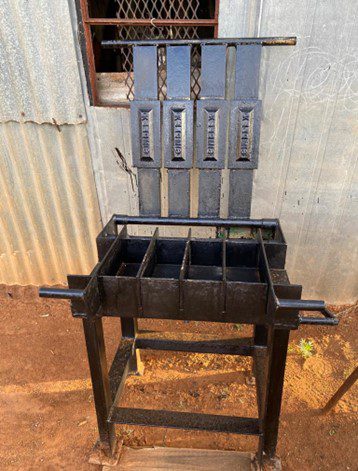
6. Conclusion of Compressed Earth Block
From an economic standpoint, there are a few factors that this paper has outlined that are critical to the development of a CEB-based industry. The first is that we do not have price-per-brick data that we can use in comparison with conventional materials to come up with a cost-per-square-meter standard. It is possible to project that, after the initial capital expenditure into the machinery, the material and labour operational expenses are fairly lower than competing fire bricks. There is a less labour-intensive process, a passive curing process, and the potential for on-site production which projects for a cheaper product. Overall, our analysis points to an economically viable option that will yield a whole set of new jobs, complementary businesses, and alternatives to highly processed conventional materials.
The environmental impact of producing and using CEBs requires some thoughtful analysis since there are aspects of embodied energy and impact offset by some relatively cleaner and raw processes. The embodied energy is in the cement (when and if required) to enhance the compressive strength and durability of CEBs as well as the associated energy required to operate the diesel-operated machinery, though there is also CEB machinery available that is manually operated. However, these costs to the environment are offset by CEBs requiring very few materials that are abundantly available across the country. There are also no toxins associated with the production of these bricks onsite.
The sociopolitical conditions forebear a high potential for the development of the CEB industry. All of the raw materials are unregulated and the process does not emit any toxins that would require further approval. Competing materials like fired bricks have created a context for digging earth for manufacturing bricks and created a marketplace for alternatives to cement blocks. The demand for these materials should not be an issue since CEBs can be seen as an alternative to fired bricks and adobe blocks which have been used for a long time in Lesotho.
7. Recommendations for Compressed Earth Blocks
Our classification of the audience for the potential of CEBs is in the state, development partners, and the private sector. To the state agencies and development partners in the green economy, this paper recommends that a rating system be developed( see Annex 1 Material Specification) to illustrate the environmental benefits of using CEBs above alternatives. Secondly, once this industry is developed, a levy on imports may be used to discourage direct competition for CEBs to curb the overall carbon footprint and cost of importing a building material we can produce locally.
Development partners include NGOs, academic institutions, and private donor institutions with an interest in the spectrum between the basic need for shelter to the development of industry. From a technical perspective, this paper recommends that in-depth research be conducted into the performance of CEBs to support their readiness for the market. With the support of NGOs and donors, better regulations may be placed on where and how to mine the earth used for CEBs and other similarly resourced bricks to ensure environmental security for future communities.
Lastly, the private sector will play a key role in maximising the benefits of CEBs’ use in construction at all levels of the industrial hierarchy. At the top level, advocacy for CEBs in line with job creation, environmental impact (positive and negative), and built industry value chain development needs the participation of influential individuals and associations (Private Sector Foundation of Lesotho and the Lesotho Chamber of Commerce and Industry). Investment into the industry from financial institutions is also key to the mobilisation of the use of CEBs through funding the required infrastructure, marketing, and labour.
Compressed Earth Blocks are economical, produce low-emissions, and are primarily locally producible building materials. They are a good alternative for low-cost housing since Adobe alternatives have been used in Lesotho in the past. There is an opportunity for the mass production of these blocks which in turn will generate manufacturing jobs. To raise awareness and create demand for this building material a highly visible and utilised demo building made from CEB should be built to train community members on how to make CEB and build with it and gauge the interest in the material once it’s known. The presses can then be left with communities as income-generating activities to make CEBs and sell them; in this way, the economy will circulate amongst the communities.
8. Appendix
| Respondent No | Name of Company | Number of Years of Experience | Profession/ Qualifying criteria |
| Respondent 1 | Dwell Earth | 30 years | Seller of CEB machinery and trainer of producing CEB |
| Respondent 2 | Blessman International (Compressed earth block constructor) | 5 years | Board of Directors of Blessmen |
| Respondent 3 | Blessman International (Compressed earth block constructor) | 7 years | Constructor and offers technical guidance on Compressed Earth Block |
| Respondent 4 | Individual Contractor | 30 years | Builder and producer of CEB in Lesotho |
| Respondent 5 | Blessman International (compressed earth block constructor) | 15 years | Constructor of Compressed Earth Block |
| Respondent 6 | Entrepreneur | 3 years | Compressed Earth |
| Respondent 7 | Natural Building Collective | 14 years | Founder facilitator and trainer |
| Respondent 8 | Limkokwing University of Creative Technology | 20 years | Head of Dept of Architecture |
| Respondent 9 | MMA Studio | 5 years | Architect |
| Respondent 10 | Natural Building Collective | 9 years | Facilitator/Trainer/ Builder |
| Respondent 11 | Morija Museum and Archives | 15 years | Deputy Curator |
9. Bibliography
Adam, E. A. & Agib, A. R.A. 2001. Compressed Stabilised Earth Block in South Sudan. https://unesdoc.unesco.org/ark:/48223/pf0000128236/PDF/128236eng.pdf.multi
Agrément South Africa .2016. 2011/397 (Amended December 2016): Compressed Earth Blocks Building System. https://agrement.co.za/active_certificate/2011-397-amended-december-2016-compressed-earth-blocks-building-system/
Arumala, J. O & Gondal, T. 2017. The Construction and Building Research Conference of the Royal Institution of Chartered Surveyors. https://www.rivendellvillage.org/Compressed_Earth_Building_Blocks.pdf.
Bowen, M. 2017. A Best Practices Manual for Using Compressed Earth Blocks in Sustainable Home Construction in Indian Country. https://www.huduser.gov/portal/sites/default/files/pdf/Compressed-Earth-Blocks.pdf
Building Impact Zero Network. 2017. Design and Build with Compressed Earth Blocks. https://www.bi0n.eu/our-work/1-design-and-build-with-compressed-earth-blocks
Contributing Writer. 2012. BENEFITS OF COMPRESSED EARTH BLOCKS: Interview with Dan Powell of EarthTek. https://greenbuildingcanada.ca/2012/benefits-compressed-earth-blocks-dan-powell-earthtek/
Earth Building Association of Australia. 2022. Earth Building. https://www.ebaa.asn.au/about/earth-building/
Finnan, D. 2018. Innovative Compressed Earth Bricks boost Gambia’s construction industry. https://www.rfi.fr/en/africa/20180727-innovative-compressed-earth-bricks-boost-gambias-construction-industry
Guillaud H, Odul P, & Joffroy T. 1995. Compressed Earth Blocks: Manual of design and construction. Volume II. Hoehl-Druck, Bad Hersfeld. Germany
Happoadmin. 2022. Compressed Stabilised Earth Blocks (CSEB) – an alternative to Clay Bricks. https://happho.com/compressed-stabilised-earth-blocks-alternative-clay-bricks/
MecoConcept. 2022. Compressed Earth Blocks. https://www.mecoconcept.com/en/green-building/compressed-earth-blocks/
Nnadi, E.O.E, & Delunzu, V.U. 2022. Cost- Cost-benefit analysis of Using Stabilized Earth Block to Conventional Block Use in Housing Construction. https://www.irejournals.com/formatedpaper/1703280.pdf
Taos. 2023. Taos Pueblo. https://taos.org/explore/landmarks/taos-pueblo/


